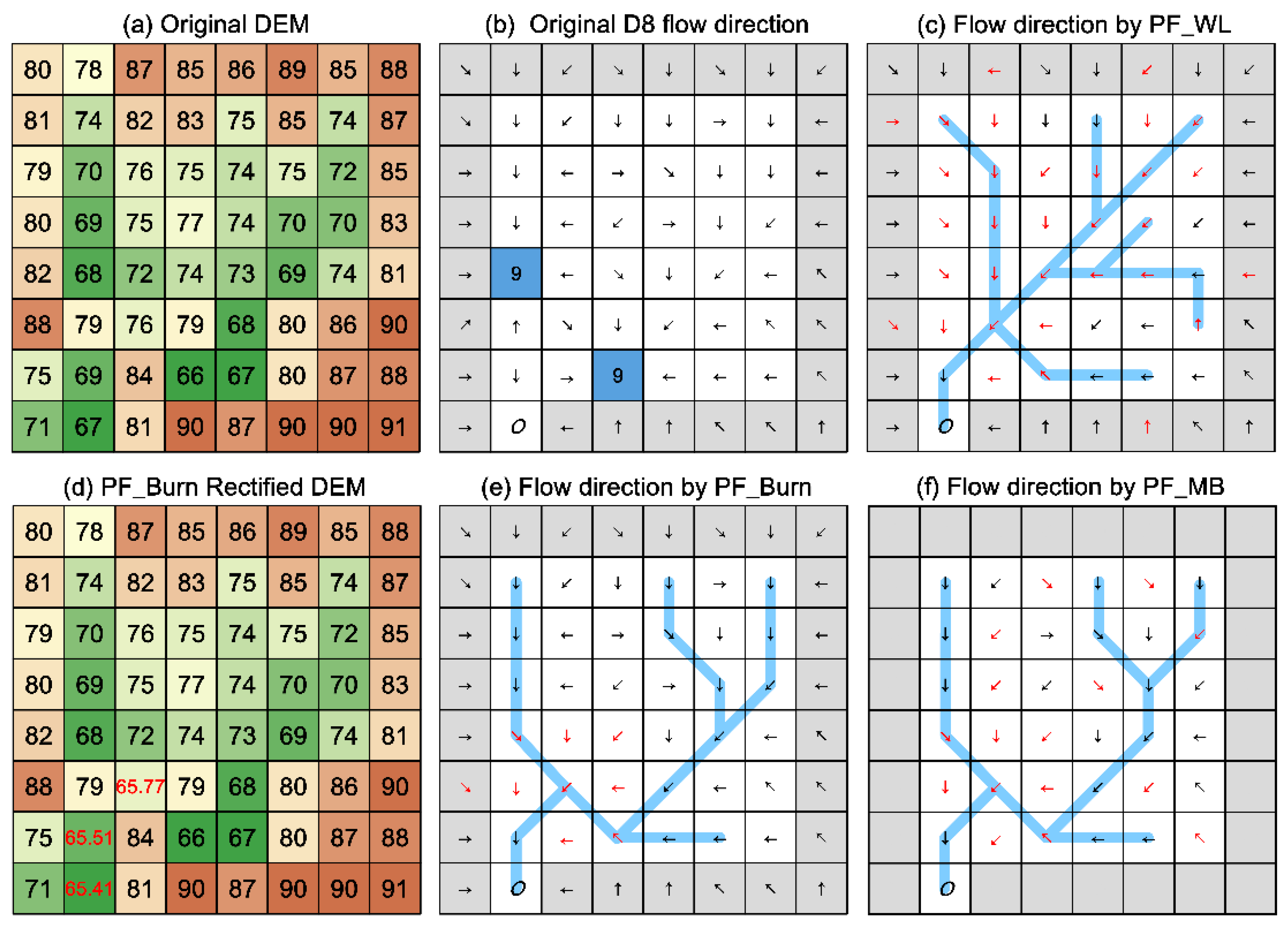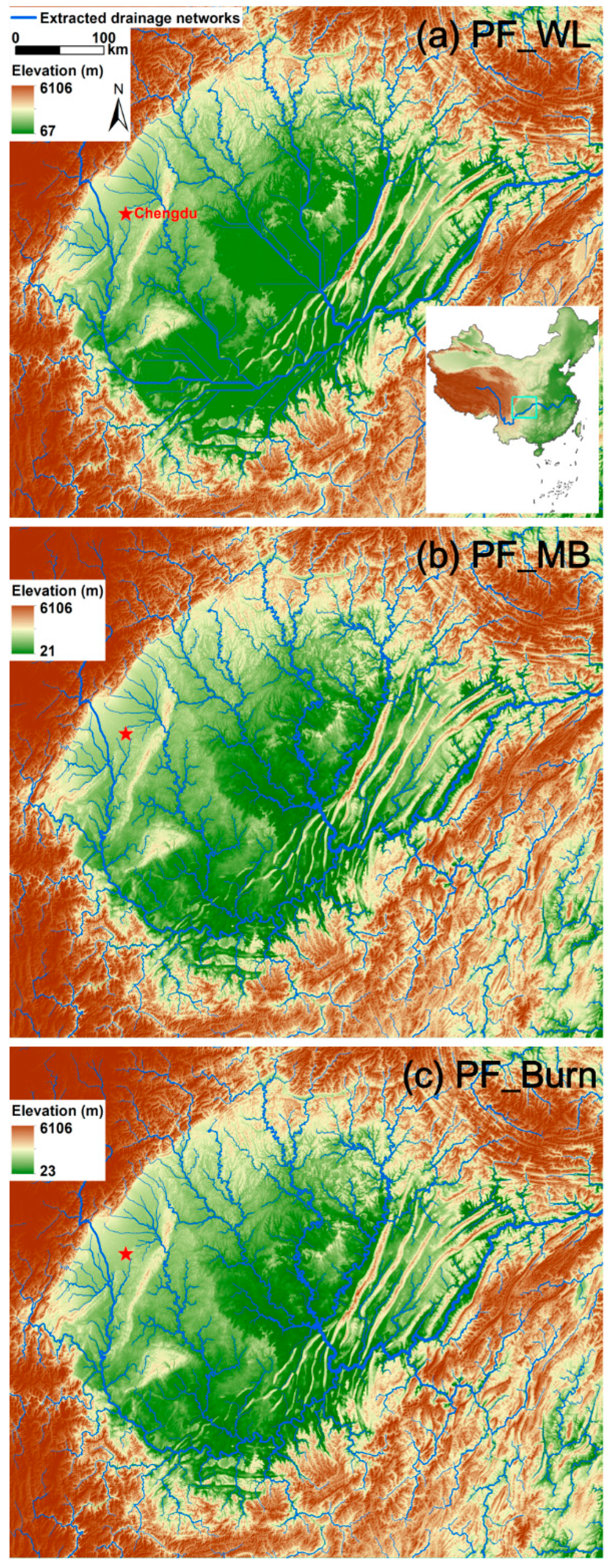Retaining Relative Height Information: An Enhanced Technique for Depression Treatment in Digital Elevation Models
Abstract
:1. Introduction
2. The New Variant
2.1. Design to Maximally Retain the Original Elevation Information
2.1.1. Brief of the Original Algorithm and Its Variant
2.1.2. Brief of the New Variant
2.2. Implementation of the New Variant
| Algorithm 1. Priority-flood-based burning (PF_Burn) algorithm |
| 1: Let DEM be the original elevation surface (i.e., input DEM) 2: Let SPILL be the intermediate elevation surface after depression filling 3: Let FlowDirD8 be the output D8 flow directions 4: Let OPEN be an empty priority queue with total order 5: Let CLOSED be a matrix of the same sizes as DEM 6: Calculate FlowDirD8 using DEM, assign the value of 9 for depression bottoms 7: Initialize CLOSED to false 8: for all c on the border of DEM 9: SPILL (c) ← DEM(c) 10: push c into OPEN with priority DEM(c) 11: CLOSED(c) ← true 12: while OPEN is not empty 13: c ← POP(OPEN) 14: CLOSED(c) ← true 15: for all 8-connected neighbors n of c 16: if CLOSED(n) then repeat the loop 17: SPILL (n) ← SPILL (c) + max(ε, DEM(n) - DEM(c) ) 18: CLOSED(n) ← true 19: push n into OPEN with priority DEM(n) 20: for all c flagged as 9 (i.e., depression bottom) in FlowDirD8 21: DEM(c) ← min(elevations of the 8 neighbors of c in DEM) 22: n ← the neighbor of c with the steepest slope (calculated in SPILL) 23: while DEM(c) ≤ DEM(n) 24: DEM(n) ← DEM(c) − ε 25: FlowDirD8(c) points from c to n 26: c = n 27: n ← the neighbor of c with the steepest slope (calculated in SPILL) |
3. A Test Using a Complex Terrain Data
3.1. Study Area and Data
3.2. Application of the New Variant
4. Conclusions and Discussion
Supplementary Materials
Author Contributions
Funding
Institutional Review Board Statement
Informed Consent Statement
Data Availability Statement
Acknowledgments
Conflicts of Interest
References
- Wang, L.; Liu, H. An Efficient Method for Identifying and Filling Surface Depressions in Digital Elevation Models for Hydrologic Analysis and Modelling. Int. J. Geogr. Inf. Sci. 2006, 20, 193–213. [Google Scholar] [CrossRef]
- Planchon, O.; Darboux, F. A Fast, Simple and Versatile Algorithm to Fill the Depressions of Digital Elevation Models. Catena 2001, 46, 159–176. [Google Scholar] [CrossRef]
- Barnes, R.; Lehman, C.; Mulla, D. Priority-Flood: An Optimal Depression-Filling and Watershed-Labeling Algorithm for Digital Elevation Models. Comput. Geosci. 2014, 62, 117–127. [Google Scholar] [CrossRef] [Green Version]
- Lidberg, W.; Nilsson, M.; Lundmark, T.; Ågren, A.M. Evaluating Preprocessing Methods of Digital Elevation Models for Hydrological Modelling. Hydrol. Process. 2017, 31, 4660–4668. [Google Scholar] [CrossRef] [Green Version]
- Marks, D.; Dozier, J.; Frew, J. Automated Basin Delineation from Digital Terrain Data. Geo-Processing 1983, 2, 299–311. [Google Scholar]
- Soille, P.; Vogt, J.; Colombo, R. Carving and Adaptive Drainage Enforcement of Grid Digital Elevation Models. Water Resour. Res. 2003, 39, 1366. [Google Scholar] [CrossRef]
- Lindsay, J.B. Efficient Hybrid Breaching-Filling Sink Removal Methods for Flow Path Enforcement in Digital Elevation Models. Hydrol. Process. 2015, 30, 846–857. [Google Scholar] [CrossRef]
- Beven, K.J.; Kirkby, M.J. A Physically Based, Variable Contributing Area Model of Basin Hydrology/Un Modèle à Base Physique De Zone D’appel Variable De L’hydrologie Du Bassin Versant. Hydrol. Sci. Bull. 1979, 24, 43–69. [Google Scholar] [CrossRef] [Green Version]
- Yan, Y.; Tang, J.; Pilesjö, P. A Combined Algorithm for Automated Drainage Network Extraction from Digital Elevation Models. Hydrol. Process. 2018, 32, 1322–1333. [Google Scholar] [CrossRef]
- Metz, M.; Mitasova, H.; Harmon, R.S. Efficient Extraction of Drainage Networks from Massive, Radar-Based Elevation Models with Least Cost Path Search. Hydrol. Earth Syst. Sci. 2011, 15, 667–678. [Google Scholar] [CrossRef] [Green Version]
- Jenson, S.K.; Domingue, J.O. Extracting Topographic Structure from Digital Elevation Data for Geographic Information-System Analysis. Photogramm. Eng. Remote Sens. 1988, 54, 1593–1600. [Google Scholar]
- Pan, F.; Stieglitz, M.; McKane, R.B. An Algorithm for Treating Flat Areas and Depressions in Digital Elevation Models Using Linear Interpolation. Water Resour. Res. 2012, 48, W00L10. [Google Scholar] [CrossRef] [Green Version]
- Zhang, H.; Yao, Z.; Yang, Q.; Li, S.; Baartman, J.E.M.; Gai, L.; Yao, M.; Yang, X.; Ritsema, C.J.; Geissen, V. An Integrated Algorithm to Evaluate Flow Direction and Flow Accumulation in Flat Regions of Hydrologically Corrected Dems. Catena 2017, 151, 174–181. [Google Scholar] [CrossRef]
- Rennó, C.D.; Nobre, A.D.; Cuartas, L.A.; Soares, J.V.; Hodnett, M.G.; Tomasella, J.; Waterloo, M.J. Hand, a New Terrain Descriptor Using Srtm-Dem: Mapping Terra-Firme Rainforest Environments in Amazonia. Remote Sens. Environ. 2008, 112, 3469–3481. [Google Scholar] [CrossRef]
- Barnes, R. Parallel Priority-Flood Depression Filling for Trillion Cell Digital Elevation Models on Desktops or Clusters. Comput. Geosci. 2016, 96, 56–68. [Google Scholar] [CrossRef] [Green Version]
- Zhou, G.; Sun, Z.; Fu, S. An Efficient Variant of the Priority-Flood Algorithm for Filling Depressions in Raster Digital Elevation Models. Comput. Geosci. 2016, 90, 87–96. [Google Scholar] [CrossRef]
- Wei, H.; Zhou, G.; Fu, S. Efficient Priority-Flood Depression Filling in Raster Digital Elevation Models. Int. J. Digit. Earth 2019, 12, 415–427. [Google Scholar] [CrossRef]
- Soille, P.; Vincent, L. Watersheds in Digital Spaces: An Efficient Algorithm Based on Immersion Simulations. IEEE Trans. Pattern Anal. Mach. Intell. 1991, 13, 583–598. [Google Scholar]
- Soille, P.; Gratin, C. An Efficient Algorithm for Drainage Network Extraction on Dems. J. Vis. Commun. Image Represent. 1994, 5, 181–189. [Google Scholar] [CrossRef]
- Zhou, G.; Zhou, J.; Li, Y. Filling Depressions Based on Sub-Watersheds in Raster Digital Elevation Models. In Proceedings of the Paper Presented at the 2017 IEEE International Geoscience and Remote Sensing Symposium (IGARSS), Fort Worth, TX, USA, 23–28 July 2017. [Google Scholar]
- Xiong, L.-Y.; Jiang, R.-Q.; Lu, Q.-H.; Yang, B.-S.; Li, F.-Y.; Tang, G.-A. Improved Priority-Flood Method for Depression Filling by Redundant Calculation Optimization in Local Micro-Relief Areas. Trans. GIS 2019, 23, 259–274. [Google Scholar] [CrossRef]
- Lindsay, J.B.; Creed, I.F. Removal of Artifact Depressions from Digital Elevation Models: Towards a Minimum Impact Approach. Hydrol. Process. 2005, 19, 3113–3126. [Google Scholar] [CrossRef]
- Wang, Y.-J.; Qin, C.-Z.; Zhu, A.X. Review on Algorithms of Dealing with Depressions in Grid Dem. Ann. GIS 2019, 25, 83–97. [Google Scholar] [CrossRef] [Green Version]
- Wolock, D.M.; McCabe, G.J., Jr. Comparison of Single and Multiple Flow Direction Algorithms for Computing Topographic Parameters in Topmodel. Water Resour. Res. 1995, 31, 1315–1324. [Google Scholar] [CrossRef]
- Quinn, P.; Beven, K.; Chevallier, P.; Planchon, O. The Prediction of Hillslope Flow Paths for Distributed Hydrological Modelling Using Digital Terrain Models. Hydrol. Process. 1991, 5, 59–79. [Google Scholar] [CrossRef]
- Tarboton, D.G. A New Method for the Determination of Flow Directions and Upslope Areas in Grid Digital Elevation Models. Water Resour. Res. 1997, 33, 309–319. [Google Scholar] [CrossRef] [Green Version]
- Soille, P. Optimal Removal of Spurious Pits in Grid Digital Elevation Models. Water Resour. Res. 2004, 40, 1–9. [Google Scholar] [CrossRef] [Green Version]
- Nobre, A.D.; Cuartas, L.A.; Hodnett, M.; Rennó, C.D.; Rodrigues, G.; Silveira, A.; Waterloo, M.; Saleska, S. Height above the Nearest Drainage—A Hydrologically Relevant New Terrain Model. J. Hydrol. 2011, 404, 13–29. [Google Scholar] [CrossRef] [Green Version]
- Nobre, A.D.; Cuartas, L.A.; Momo, M.R.; Severo, D.L.; Pinheiro, A.; Nobre, C.A. Hand Contour: A New Proxy Predictor of Inundation Extent. Hydrol. Process. 2016, 30, 320–333. [Google Scholar] [CrossRef]
- Liu, Y.; Maidment, D.; Tarboton, D.; Zheng, X.; Yildirim, A.A.; Sazib, N.; Wang, S. A Cybergis Approach to Generating High-Resolution Height above Nearest Drainage (Hand) Raster for National Flood Mapping. In Proceedings of the Paper Presented at the International Conference on Cybergis and Geospatial Data Science 2016, Urbana, IL, USA, 24 June 2016. [Google Scholar]
- Orlandini, S.; Moretti, G. Determination of Surface Flow Paths from Gridded Elevation Data. Water Resour. Res. 2009, 45, 1–14. [Google Scholar] [CrossRef] [Green Version]
- Shin, S.; Paik, K. An Improved Method for Single Flow Direction Calculation in Grid Digital Elevation Models. Hydrol. Process. 2017, 31, 1650–1661. [Google Scholar] [CrossRef]
- Costabile, P.; Costanzo, C. A 2d-Swes Framework for Efficient Catchment-Scale Simulations: Hydrodynamic Scaling Properties of River Networks and Implications for Non-Uniform Grids Generation. J. Hydrol. 2021, 599, 126306. [Google Scholar] [CrossRef]
- Xia, X.; Liang, Q.; Ming, X. A Full-Scale Fluvial Flood Modelling Framework Based on a High-Performance Integrated Hydrodynamic Modelling System (Hipims). Adv. Water Resour. 2019, 132, 103392. [Google Scholar] [CrossRef]
- Nguyen, P.; Thorstensen, A.; Sorooshian, S.; Hsu, K.; AghaKouchak, A.; Sanders, B.; Koren, V.; Cui, Z.; Smith, M. A High Resolution Coupled Hydrologic–Hydraulic Model (Hiresflood-Uci) for Flash Flood Modeling. J. Hydrol. 2016, 541, 401–420. [Google Scholar] [CrossRef] [Green Version]


Publisher’s Note: MDPI stays neutral with regard to jurisdictional claims in published maps and institutional affiliations. |
© 2021 by the authors. Licensee MDPI, Basel, Switzerland. This article is an open access article distributed under the terms and conditions of the Creative Commons Attribution (CC BY) license (https://creativecommons.org/licenses/by/4.0/).
Share and Cite
Chen, B.; Ma, C.; Xiao, Y.; Gao, H.; Shi, P.; Zheng, J. Retaining Relative Height Information: An Enhanced Technique for Depression Treatment in Digital Elevation Models. Water 2021, 13, 3347. https://doi.org/10.3390/w13233347
Chen B, Ma C, Xiao Y, Gao H, Shi P, Zheng J. Retaining Relative Height Information: An Enhanced Technique for Depression Treatment in Digital Elevation Models. Water. 2021; 13(23):3347. https://doi.org/10.3390/w13233347
Chicago/Turabian StyleChen, Bo, Chunying Ma, Yao Xiao, Hanxin Gao, Peijun Shi, and Jing Zheng. 2021. "Retaining Relative Height Information: An Enhanced Technique for Depression Treatment in Digital Elevation Models" Water 13, no. 23: 3347. https://doi.org/10.3390/w13233347
APA StyleChen, B., Ma, C., Xiao, Y., Gao, H., Shi, P., & Zheng, J. (2021). Retaining Relative Height Information: An Enhanced Technique for Depression Treatment in Digital Elevation Models. Water, 13(23), 3347. https://doi.org/10.3390/w13233347






